 |
| My Facebook Shop |

What? A selection of Viking era beads strung together in heraldic groupings.
Where? Colours, sizes, and shapes based on Viking finds throughout Norway, Denmark and Sweden.
 |
When? 793-1066AD
Why? I choose to complete a special string of beads for my husband, children and myself in our favourite colours, which also happen to be our Heraldic colours. Viking strands and necklaces have a striking variety in the way that they are composed. Some are multi-coloured, some are symmetrical, others have only one or few colours. Most Viking glass bead finds were disturbed, so the composition of necklaces may be to modern tastes, rather than the actual arrangement of the time.
I have included images of a variety of examples that I have taken inspriation from.
String: There was no obvious material remaining to show what the beads were strung on, but organic material such as a leather or cotton cord would have been common. (Holgate) I have chosen to use bronze wire and cotton cord, though I have used silver wire for the children’s necklaces.
I have been working on developing my skill at melting glass and shaping it over the last year. I have learnt a lot, including where in the flame certain glass must be placed so that it doesn’t ruin the colour or texture. I have learnt how to steadily place my hands and rotate both glass and mandrel so that an even amount of glass, at the right temperature, is kept at the right heat to reproduce the desired bead.
The necklaces and strands presented a variety of challenges. Glass is a dangerous, sometimes fickle substance, and certain colours only work properly at a certain heat.
Some of the trickier techniques (and melting glass onto a mandrel and keeping it even is tricky to start with!) that I used for this project include:
• Studying each (photo of) bead in a variety of lights to get an accurate grasp of the details and finishes required.
• Working with tricky colours such as white, yellow, turquoise, and light blue which can be easy to “burn” or mutate colour.
• Combining colours and the perfect melt down spot to get a more accurate shade and shape.
• Creating the beads with “eye” decoration in the right size and number. The more complicated beads can have over 40 individual steps in the creation of circles and melting in of shapes.
• Ensuring that I copied the “flawed” beads as well, to accurately represent the extant pieces. As a perfectionist- trust me when I say this was possibly my hardest challenge!
• Shaping similar size beads but also recreating subtle differences such as size and shape.
• Creating stringers for finer detail in the small dots. One needs to carefully pull glass at a specific pace to achieve this.
• Certain shapes, such as the double eyes, require precise manoeuvring and shaping- the use of a knife needed to recreate the shape.
• Using techniques such as flattening the dots between each layer, melting them in completely before adding in the new layer, and then applying the final tiny circle.
• I used a graphite paddle, mandrels, bead release, a knife, fire annealing and gravity. I try to use the least tools possible and authentic equipment that would have been used by the glassmakers of the time. Apart from my fire set-up, all the equipment I have used would have been used at the time as well.
• Clear broken glass was often used as well as imported blocks of coloured glass. (Regia Anglorum)
• The glass rods I used to recreate these beads were Effetre Murano – 104 COE soft glass rods. This is a close replica of the glass that would have been used at the time.
• Bead artisans would have created a small kiln or furnace. The broken recycled glass would be put into the furnace through holes in the side to melt in a dish inside the furnace. Air was pumped into the furnace to keep the charcoal hot. (Guido)
• I use a hot head torch and MAPP gas. In the future I have plans to recreate a small portable kiln but melting glass in a small kiln is very difficult as getting the heat hot enough to melt the glass is a struggle.
• Metal rods (mandrels) were dipped with a clay mixture called bead release. The molten glass is wound onto the rod until the desired shape was achieved. Once the bead size and shape were achieved, a design could be added by heating thin bits of glass and wrapping them around the bead, with a “stringer” that was heated and laid on top. (Guido)
• I use mandrels that would have been very similar to those used, however, mine are shorter as they don’t need to be as long to reach into a hot fire. The bead release I use has the crucial ingredients of water, kaolin and alumina hydrate, which is a composition that would have been used.
• Beads would then be moved to an annealing dish in the furnace.This would prevent thermal shock, lowering the chances of the bead cracking.
• Instead of annealing them in a furnace, I use a product called vermiculite to allow the beads to cool down slowly. I also use a kiln. In the future, I would like to try annealing them in a furnace to see what it is like.
• After the beads are finished, I remove them from the mandrels, clean them out with some bead cleaning tools and give them a quick clean with some soapy water.
• In the future, I would like to continue to practice more difficult skills, e.g., fine line work, millefiori use and making the Chinese Warring state Beads which had over 100 steps each.
• For this project, I would continue to find examples that validate the authenticity of the piece.
• I am enjoying creating pieces from different times and cultures and I will continue to develop my skills by continuing to choose challenging projects.
• I also enjoyed working with the museum and the professor when I recreated a 133 bead Phoenician necklace, and I would like to continue working with people like this. Not only was it very educational and rewarding, but it resulted in me contributing to the historical accuracy of the museum- which I thought was cool!
• I also intend to work on another historical recreation of a glass making set up.
Primary Resources:
Secondary Resources:
Image credits
 |
Figure 1- Image of my recreation |
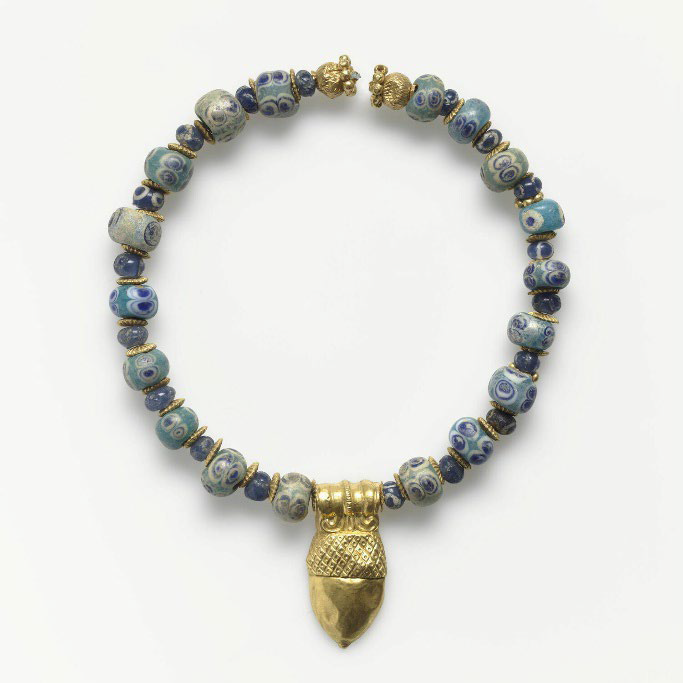 |
Figure 2- Image from the Louvre |
What? Hellenistic Necklace
Where? Italy
When? Hellenistic Period- CA 323 BC-31BC
Why? I chose this necklace as I was researching alternate historical resources to what I had been using previously (the Louvre). I had to put my language skills to the test as most of the searching had to be done in French, and most of the information I had to translate as well. I needed something gold, to suit the competition, but I fell in love with the blue beads as it’s one of my favourite colours, and part of my heraldry. The glass eye beads are fascinating as they demonstrate exactly how beads were traded and how they made their way all over the world. Beads such as these are found throughout a variety of cultures and ages.
Details of the extant pieces:
https://collections.louvre.fr/en/ark:/53355/cl010257015
Dimensions: Height: 30cm; Width: 3.8cm; Depth: 1cm; Weight: 28.47g per bead
Materials and techniques:
Details of the Recreation:
I chose to recreate the 36 glass beads that are on display for historical accuracy. I worked with the Louvre museum's high-resolution image to recreate each bead with its unique characteristics. Each bead took me about 5-20 minutes of time to recreate, making the whole project about 10 hours of work, over a couple of weeks.
This necklace has a couple of components that I needed to outsource. My focus was on creating the glass beads for this necklace, and not the additional findings. Historically these findings may have been purchased or traded separately to the making of the glass beads. I purchased gold spacers that were like the extant piece, and I recreated the acorn. It is recreated to meet the visual aesthetic of the extant piece and has not been produced how it would have been, as that is not an element I am focussing on now. In the future I may look at casting these pieces myself to complete the recreation of the entire piece authentically.
 |
| Figure 3 - A similar bead. https://www.metmuseum.org/art/collection/search/249931 |
 |
| Figure 4 - Another similar bead, though a cool variant. https://www.metmuseum.org/art/collection/search/239588 |
 |
Figure 5- A similar necklace from the same time period: https://www.britishmuseum.org/collection/object/G_1872-0604-644 |
Working with Glass:
I have been working on developing my skill at melting glass and shaping it over the last year. I have learnt a lot, including where in the flame certain glass must be placed so that it doesn’t ruin the colour or texture. I have learnt how to steadily place my hands and rotate both glass and mandrel so that an even amount of glass, at the right temperature, is kept at the right heat to reproduce the desired bead.
The necklace presented a variety of challenges. Glass is a dangerous, sometimes fickle substance, and certain colours only work properly at a certain heat.
Some of the trickier techniques (and melting glass onto a mandrel and keeping it even is tricky to start with!) that I used for this project include:
Details of the equipment and resources:
 |
| Figure 6- Working closely with a copy of the image to reproduce the item authentically. |
 |
| Figure 7 - Finished copy of the necklace that I made. |
Future Projects:
Resources:
Primary Resources:
Secondary Resources:
Image credits
Documentation
Reproduction of Chinese Warring State Beads
What? A selection of Chinese Warring State glass beads.
Where? China
Why? The warring state beads are fascinating as they demonstrate the trade and influence of other civilisations with China. You can see similar beads such as the yellow and blue circular bead found throughout different time periods and cultures. (See picture on the left). The warring state beads differ from their European counterparts in their complexity and their chemical composition.
Details of the extant pieces
Please refer to the attached appendix which has an easy reference guide to each bead chosen and recreated. These beads were generally not all found at the same time or in the same places. I chose to string mine all together on a metal necklace as I needed to keep the entry small and secure as a friend is very kindly transporting it from Canberra to New Zealand. Most of these beads
are generally displayed as individual items in museums. There was no obvious material remaining to show what the beads were strung on, but organic material such as a leather cord would have been common. (Holgate)
I chose to recreate a number of beads that are on display in a variety of museums to ensure historical accuracy. I worked with each museum's high-resolution images to recreate the beads with their unique characteristics.
These beads are intricate and take forty-five minutes for the simplest, to over an hour and a half for the more complicated beads. The whole project took about 40 hours of work, over a couple of months. The reason for this is that the turquoise colour is very hard to not burn, and the white is also difficult to keep “clean” as it’s in the flame for so long. As such, I had to redo these many times. Added to this, is the fact that the bigger the bead, and the more additional steps and glass, the more likely the bead may crack or shatter. (Which is heart breaking when you spend an hour on one!) I also read through stacks of articles and books and had to learn some Chinese to navigate some of these searches. Glass in this context is called liuli. (Kwan)
The hole of each bead is considerable for most of these beads. As such I used the “3-5mm” sized mandrel which tracks accurately with the sizing and shape of the beads, and the dimension notes mentioned by the museums.
Additionally, there are many centuries of wear on the beads that are on display. This means that colours and details are faded, and many of the beads have faults such as chips etc. The use of a different glass composition is noticed in the wear on the beads from China- the colour is much more faded, and the surface is quite degraded.
I have been working on developing my skill at melting glass and shaping it over the last year. I have learnt a lot, including where in the flame certain glass must be placed so that it doesn’t ruin the colour or texture. I have learnt how to steadily place my hands and rotate both glass and mandrel so that an even amount of glass, at the right temperature, is kept at the right heat to reproduce the desired bead.
The warring state beads presented a variety of challenges. Glass is a dangerous, sometimes fickle substance, and certain colours only work properly at a certain heat. Some of the trickier techniques (and melting glass onto a mandrel and keeping it even is tricky to start with!) that I used for this project include:
I did not use the lead barium glass as it’s not commonly used, and the toxicity is not something I wish to be exposed to. I use Effetre Glass which has a working temperature of 945 °C. Effetre is a variety of soda-lime glass.
The earliest-known method of glass manufacturing in China, the alkali (generally potash) and lime glass system, soon gave way to the lead-barium system of glass production that characterised the Warring States period. While archaeologists are not entirely sure why the Chinese first chose to work with this formula, it is believed that the wide availability of both lead and barium and the fact that this composition lowered the melting point of the glass played a role. (As discussed in Early Manufacturing Techniques, the furnaces used in ancient times often struggled to produce enough heat to melt glass.) Produced in the Yangtze River valley region, lead-barium glass soon became very popular within China and was circulated throughout the more accessible areas of that vast country.
Making the glass beads
Future Projects:
Resources:
Primary Resources:
High-Resolution Copy of the extant beads. Images and links to their original museum location can be found in the appendix.
Secondary Resources:
Image credits
Websites

Figure 1- Image of the recreation necklace- C Merritt
| Figure 2- Image of original necklace held by the MET |
What? 133 Glass eye beads forming a necklace. I’ve added two extra beads, as the originals were also found with the others, but one was broken and the other one went missing so they couldn’t be displayed.
Where? Phoenician
When? Hellenistic Period
Why? The glass eye beads are fascinating as they demonstrate exactly how beads were traded and how they made their way all over the world. You can also see how the same beads are made in many different time periods and cultures. I will include examples of the exact same bead (in terms of colours, dimensions, and decorations) so that you can see the extent to which they travelled locations and time. When looking at this “necklace” or “collection”, I have noticed several things about it which are fascinating on a scholarly level. Firstly, I believe they were made by several different people, including perhaps an apprentice. Secondly, considering how many there are in very similar forms, I wonder if they were made to sell at a market instead of worn by one person. Thirdly, I have worn the necklace as a double strand necklace, and it is comfortable, though I would say extravagant, and non-practical.
Details of the extant piece:
 |
| Figure 3- Image of a Phoenician woman wearing a similar necklace |
 |
Figure 4- Example of similar beads |
Description
Opaque yellow, with translucent blue and opaque white stratified eyes. String of 133 eye beads of various shapes, sizes, and designs, many comprising two beads fused together, and all having a large thread-hole. The stratified eye decoration is composed of a blob of opaque white with an overlay of a thin blue circle surrounding a large blue spot. All but one of the beads are intact, the exception having a chip to one side of the thread-hole; slight dulling, with deep pitting on a few of the central blue spots. The beads formed a necklace that probably had an apotropaic as well as a decorative purpose. Strings of similar beads are known from sites throughout the ancient world; for example, there are ten beads in the Department of Egyptian Art that were formerly in the collection of the Reverend Chauncey Murch, who was active as a missionary in Egypt between 1883 and 1906. Stated in the departmental records as comprising 135 beads².
String: There was no obvious material remaining to show what the beads were strung on, but organic material such as a leather or cotton cord would have been common.³
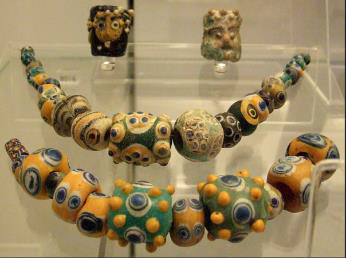 |
Figure 5- Example of similar beads |
Details of the Recreation
I chose to recreate the 133 beads that are on display for historical accuracy. I worked with the MET museum's high- resolution image to recreate each bead with its unique characteristics. Each bead took me about 20 minutes of time to recreate, making the whole project about 60 hours of work, over 3 months.
As mentioned in Myers⁴, the diameter of the individual beads is 1-1.3 cm, and the hole of each bead is considerable. As such I used the 3.2 mm and 5mm sized mandrel which both track accurately with the sizing and shape of the beads.
I followed up with Christopher Lightfoot, the author of The Cesnola Collection of Cypriot Art: Ancient Glass, to double check the accuracy of the recreation. The measurements on the Met Museum website for the string did not make sense, and when I recreated the piece based on the sizing of the beads as well as the visual cues in photos of the extant beads, the measurement still did not work. I contacted Chris who worked at the museum as a Curator for thirty years. The museum pulled the piece out to check it and then updated the description so that it is now correct, based on my feedback. ( How cool!)
A point to note is that there is thousand-year-old wear on the beads that are on display. This means that whilst the bead may now appear quite square, they would have been rounder when freshly made. Colours and details are faded, and many of the beads have wear such as chips and odd rubbing marks etc. Interestingly, many of the beads appear to have frequent wear near the eye, which makes it seem as they were rubbed often there- this would make sense if the wearer believed that rubbing the eye would protect them from evil spirits
I have been working on developing my skill at melting glass and shaping it over the last year. I have learnt a lot, including where in the flame certain glass must be placed so that it doesn’t ruin the colour or texture. I have learnt how to steadily place my hands and rotate both glass and mandrel so that an even amount of glass, at the right temperature, is kept at the right heat to reproduce the desired bead.
The necklace presented a variety of challenges. Glass is a dangerous, sometimes fickle substance, and certain colours only work properly at a certain heat.
Some of the trickier techniques (and melting glass onto a mandrel and keeping it even is tricky to start with!) that I used for this project include:
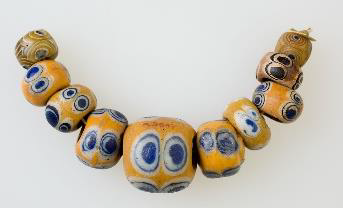 |
Figure 6 -10 beads from the Egyptian Department |
I included several beads that were created using the same materials available in the creation of the original necklace. I have arranged the colours in different ways and melted the dots in at different levels. As you can see, the result is quite different to the original, and I must say the original colour scheme is quite striking comparatively.
 |
Figure 7- A photo of the original beads |
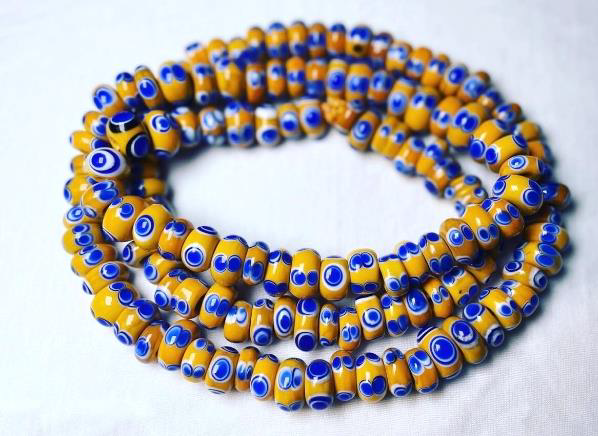 |
Figure 8- A photo of the reproduction beads |
Making the glass beads
 |
Figure 9- After a long session and fresh off the mandrel |
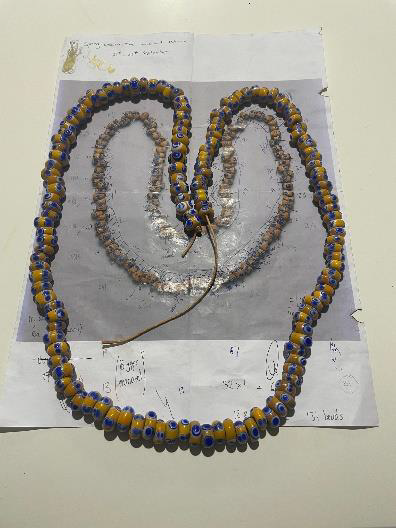 |
Figure 10 - The beads I made and my trusty printed photo of the original beads |
Future Projects
 |
Figure 11- Worn as a double strand- glass is weighty but feels nice. |
 |
Figure 12- The strand is quite long! |
Primary Resources:
High-Resolution Copy of the extant necklace: https://www.metmuseum.org/art/collection/search/239901
Secondary Resources:
Figure 1 Image of original necklace held by the MET Met Museum
Figure 2 Image of the recreation necklace- C Merritt Carina Merritt
Figure 3 Image of a Phoenician woman wearing a similar necklace Sanford Holst
Figure 4 Example of similar beads https://archaicwonder.tumblr.com/
Figure 5 Example of similar beads flickr.com/photos/kotomi-jewelry/
Figure 6 10 beads from the Egyptian Department Met Museum
Figure 7 A photo of the original beads Christopher Lightfoot
Figure 8 A photo of the reproduction beads Carina Merritt
Figure 9 After a long session and fresh off the mandrel Carina Merritt
Figure 10 The beads I made and my trusty printed photo of the original beads Carina Merritt
Figure 11 Worn as a double strand- glass is weighty but feels nice. Carina Merritt
Figure 12 The strand is quite long! Carina Merritt